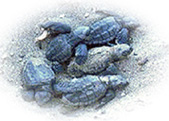|
 There
are two main types of sea-turtles nesting along the coasts of
Northern Cyprus; these are: Caretta-Caretta (Sini Kaplumbagasi),
and Chelonia-Mydas (Yesil Kaplumbaga). The both are listed as
endangered species and under strict protection. There
are two main types of sea-turtles nesting along the coasts of
Northern Cyprus; these are: Caretta-Caretta (Sini Kaplumbagasi),
and Chelonia-Mydas (Yesil Kaplumbaga). The both are listed as
endangered species and under strict protection.
About
46 sandy beaches in North Cyprus comprise the main nestling
ground for these endangered Chelonia Mydas and Caretta Caretta sea
turtles in the Eastern Mediterranean. In 1992, about 1,500 rare
female turtles laid eggs on the shores of North Cyprus.
The egging
season of these sea-turtles is from mid-May until mid-October.
The turtles make their nests [in the beach] by digging the sand
30-60 cm deep. If they succeed laying their eggs and that the
eggs are not harmed, the baby turtles crawl down to the sea in
about 55-60 days. And if the baby turtles manage to survive,
they come back to lay their eggs there in 30 years time.
 It
is noted that only one out of four thousand baby sea-turtles
manage to survive until their adolescence. During their
lifetime, and especially when they lay their eggs, the
sea-turtles are especially vulnerable to external dangers, such
as other sea or land animals, noise, pollution, rubbish, and et
cetera. It
is noted that only one out of four thousand baby sea-turtles
manage to survive until their adolescence. During their
lifetime, and especially when they lay their eggs, the
sea-turtles are especially vulnerable to external dangers, such
as other sea or land animals, noise, pollution, rubbish, and et
cetera.
The Environmental
Protection Office of Northern Cyprus, together with environment
related NGOs [such as Society for Protection of Marine-turtles,
Green Peace Movement of N.Cyprus, and N.Cyprus National Trust]
are very active in the protection of the sea turtles of Northern
Cyprus, which is home to these friendly guests of our island.
|









